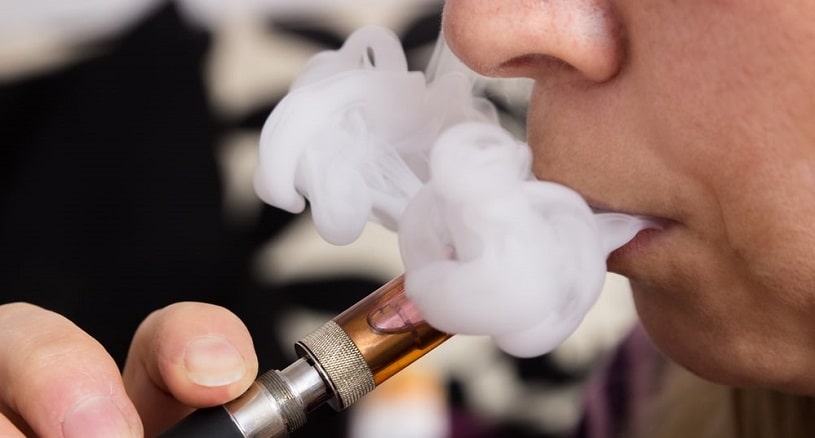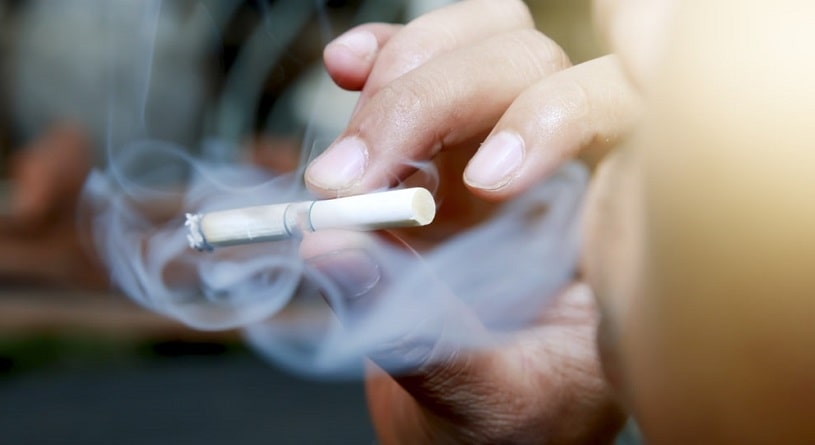Nicotine poisoning occurs when an individual consumes too much nicotine within a short period of time. Nicotine is a hazardous substance, but it rarely leads to immediate toxicity when consumed in little amounts. However, the acute lethal dose is still highly debated, especially in young children. This does not mean that the dangers are any less real. Let’s look at causes, how much it takes to overdose, the symptoms, and how this condition can be treated.
Table Of Contents:
Causes Of Nicotine Poisoning
Nicotine poisoning is relatively uncommon, and it is more difficult to overdose on the toxin than other drugs. While it is theoretically possible to consume too much nicotine through smoking, it is highly unlikely because of several reasons. Firstly, the amount in a traditional cigarette is less concentrated than that obtained from newer methods such as smoking e-cigarettes and patches. Also, your body only absorbs about one-tenth of the substance gotten through smoking a traditional cigarette compared to vaping, which involves rapidly heating a concentrated liquid form. It can lead to accidental ingestion through swallowing. Lastly, because people consider these newer forms to be “safer” than smoking traditional cigarettes, they tend to consume more. This excess use can lead to accidental poisonings.

Therefore, nicotine poisoning is more common in individuals who use gums, lozenges, patches, and vaping or e-cigarettes. Children, who are the most vulnerable group when it comes to accidental ingestion, and tobacco pickers, who come in contact with wet tobacco leaves and absorb the drug through their skin, are also at risk.
How Much Does It Take To Overdose?
Initial sources placed the lethal dose around 30-60 mg for adults, equivalent to ingesting five cigarettes or 10 ml of a dilute liquid form of the drug. Still, current estimates suggest a lower limit of 0.5-1g taken orally can cause a fatal outcome. Estimating the exact amount that is considered lethal is difficult due to practical reasons related to wide variations among people in age, weight, health status, and even their tolerance to the substance. Plant alkaloid poisoning is a primary medical concern among young children. Accidental ingestion of cigarette butts (which may contain as little as 5-7mg) and other tobacco products can prove potentially fatal to them due to their smaller body weight and fragile organs.
Nicotine Overdose Death
Death caused by nicotine overdose is very rare. Sometimes, people ingest pesticides that tobacco contains, according to the cases people report. Almost all the cases of death from the substance have been from this, including accidental and intentional poisonings. While information related to overdoses is rare and unreliable due to underreporting of information, in 2013, there was a 300% increase in reports of poisoning owing to increased e-cigarette use. The same source reported 651 accidental exposures to harmful levels of the substance, more than half of which involved children below the age of six.
Nicotine Overdose Symptoms
The nicotine poisoning symptoms may vary depending on the amount of the drug ingested, the route of ingestion, and various person-specific attributes such as age, sex, weight, health status, chronic drug use, and so on. Generally, nicotine overdose symptoms develop rapidly. Within minutes of ingesting the harmful dose, the individual begins to feel the effects.

The drug is a poison that works through the excessive stimulation and eventual blockade of nicotinic acetylcholine receptors. Acetylcholine is an important neurotransmitter that has numerous effects throughout the body. Dysregulation of these functions leads to various symptoms and may even prove to be potentially fatal. The symptoms in a mild overdose manifest majorly as gastrointestinal effects.
Within Minutes You’ll Notice Symptoms Such As:
- Nausea
- Vomiting
- Abdominal pain
- Excessive salivation
These effects usually all present within an hour of ingestion.

In addition to the above symptoms of nicotine poisoning, severe overdoses also affect other systems such as the central nervous system, respiratory system, and cardiovascular system. The symptoms of severe poisoning can be divided into early and late signs. The early nicotine poisoning symptoms usually occur within an hour of ingesting the substance.
They Include:
- Nausea
- Vomiting
- Abdominal pain
- Excessive salivation
- Increased heart rate
- Raised blood pressure
- Shortness of breath
- Wheezing
- Agitation
- Muscle twitching
- Seizures
The late symptoms may usually develop between 1-4 hours after accidental ingestion of the poison and are more common in larger overdoses. These may indicate a potentially fatal overdose or suicidal attempts.
They Include:
- Reduced heart rate
- Abnormal heart rhythms (arrhythmias)
- Low blood pressure
- Low breathing rate
- Temporary cessation of breathing
- Muscle paralysis
- Lethargy
- Shock
- Coma
Nicotine Overdose Treatment
There is no known medical antidote to treat nicotine overdose. Available medications help to improve the overdose symptoms and ease the recovery. An immediate treatment produces successful results in almost every case of overdose.
The Medications that Provide Supportive Medical Treatment Include:
- Activated charcoal – if the patient is conscious and able to take it by mouth. Also, this treatment is more effective if the poisoning time has not gone beyond a few hours. This may help to reduce the absorption inside the digestive tract.
- Benzos to control seizures
- Fluid and salt injection to control low blood pressure
- Atropine – This is a naturally occurring chemical. It acts against the activities of ACh to treat slowed pulse
- If breathing is very slow, the doctor may recommend artificial ventilation. It will support natural breathing
A Second Chance
Nicotine overdose is becoming an increasingly serious health and safety issue, especially with the rise in the use of more concentrated forms such as patches and e-cigarettes. Overdoses that were previously almost unheard of are becoming increasingly common, especially among young children who may mistake replacement therapy products (gums or lozenges) for candy. So one might ask the question, what is the best way to avoid overdosing? Well, the answer is quite simple, stop taking the drug.

However, this is easier said than done due to its strong addictive properties. That is why individuals who wish to quit smoking and consuming the drug in any form require professional help. Professional drug rehabilitation programs can provide you with the information, medical expertise, and related support you need to overcome nicotine addiction and control the unpleasant withdrawal symptoms. The chances of an overdose may be rare, but they are also very real.
Hope Without Commitment
Find the best treatment options. Call our free and confidential helpline
Most private insurances accepted
Page Sources
- National Institute on Drug Abuse. Cigarettes and Other Tobacco Products. 2018. https://www.drugabuse.gov/publications/drugfacts/cigarettes-other-tobacco-products.
- Genetic Science Learning Center. How Drugs Can Kill. https://learn.genetics.utah.edu/content/addiction/drugskill/
- Mhedi Belkoniene, Jennifer Socquet, Denise Njemba-Freiburghaus & Cyril Pellaton. Near fatal intoxication by nicotine and propylene glycol injection: a case report of an e-liquid poisoning. 2019. https://bmcpharmacoltoxicol.biomedcentral.com/articles/10.1186/s40360-019-0296-8
- The National Institute for Occupational Safety and Health. Nicotine. May 2011. https://www.cdc.gov/niosh/ershdb/emergencyresponsecard_29750028.html
- Bernd Mayer. How much nicotine kills a human? Tracing back the generally accepted lethal dose to dubious self-experiments in the nineteenth century. October 2013. https://www.ncbi.nlm.nih.gov/pmc/articles/PMC3880486/
- Adam Miller. Nicotine poisoning increase due to e-cigarettes. July 2014.https://www.ncbi.nlm.nih.gov/pmc/articles/PMC4081231/
- Green Tobacco Sickness in Tobacco Harvesters -- Kentucky, 1992. https://www.cdc.gov/mmwr/preview/mmwrhtml/00020119.htm
- Center for Disease Control and Prevention. Emergency Preparedness and Response. Case Definition: Nicotine Poisoning. April 2018. https://emergency.cdc.gov/agent/nicotine/casedef.asp
- A Woolf, K Burkhart, T Caraccio, T Litovitz. Self-poisoning among adults using multiple transdermal nicotine patches. 1996. https://pubmed.ncbi.nlm.nih.gov/8941198/
- Aseem Mishra, Pankaj Chaturvedi, Sourav Datta, Snita Sinukumar, Poonam Joshi, and Apurva Garg. Harmful effects of nicotine. January-March 2015. https://www.ncbi.nlm.nih.gov/pmc/articles/PMC4363846/

 Authored by
Authored by  Reviewed by
Reviewed by 

